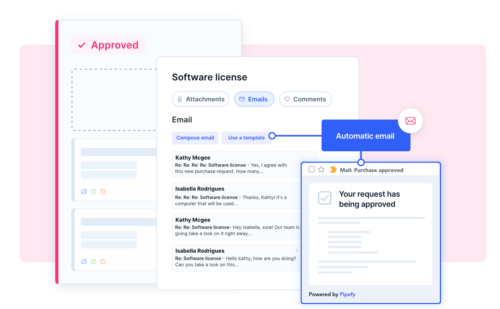
Many people talk about procurement and supply chain management as if they are identical processes, but there are important differences between the two. Supply chain management is the handling of the entire production flow of goods or services — from ordering the raw components to the final product delivery; whereas procurement is just one aspect of supply chain management.
In this article, we’ll consider the details of both procurement and supply chain management, what each process consists of, and how to distinguish between the two.
Procurement teams need agility. IT needs control and oversight. Find out how no-code automation achieves both with No-Code Automation: Good for Business, Great for IT
What is procurement?
Procurement is the process by which organizations source goods and services to achieve their objectives and meet their business needs. It’s one step in the supply chain management process. Procurement involves everything it takes for a company to acquire the goods and services it needs, including planning, quality control, pricing, supplier selection, and waste management.
There are two types of procurement:
- Direct procurement is when a company acquires goods, materials, and services that are related to key business practices and are made regularly. The items received directly affect the company’s business goals and bottom line.
- Indirect procurement relates to the acquisition of goods and services that keep the company afloat, but don’t necessarily affect the bottom line. Examples include office supplies or services like accounting.
The procurement process is the series of steps or activities that an organization performs as part of its procure-to-pay cycle—from identifying the procurement needs, running RFPs or RFQs, all the way to the point of invoicing and payment.
Elements of the procurement process
There are several steps in the procurement process:
- Vendor selection. Before a company can order and request materials, a procurement professional must choose a supplier. This involves researching vendors and choosing the best one for an organization’s needs.
- Purchase orders. A purchase order outlines the type of goods and services needed, the amount of each, as well as the cost-per-unit and total cost. It ensures the supplier or client is aware of the deliverables and receivables.
- Receiving. Receiving the goods and services includes accepting and inputting everything that was ordered, and verifying correct amounts and types via a purchase receipt. This step also includes storing and organizing any necessary items.
- Invoice and payment—The procurement process ends with a successful payment between the company and the supplier. This involves receiving an invoice for the services and goods provided, inputting and approving the payment, and successfully sending the money to the vendor.
The procurement process involves a lot of tracking and updating, which is why many companies have a procurement manager.
What does a procurement manager do?
Procurement managers are responsible for eliminating waste in the procurement process, controlling costs, and optimizing the buying process. They manage vendors and suppliers, negotiate payment, and ensure the process is as organized as possible.
Here are some examples of a procurement manager’s responsibilities:
- Eliminating waste in the procurement process. An excess of suppliers leads to more transactions and invoices, which requires additional time and human resources to complete tasks. Streamlining the process and reducing the number of suppliers can help eliminate waste.
- Controlling costs. This can include researching new suppliers to find the same or similar goods and services for less money. It also can involve onboarding new automated systems that reduce friction in payment and processing procedures and free up time for other tasks.
- Optimizing the buying process. There are many steps to oversee in the buying process, including creating purchase orders, shipment, receiving, and invoicing. By optimizing the buying process, the procurement manager can help streamline these steps and increase efficiency.
Now, how does procurement fit into overall supply chain management? Let’s take a look at what the supply chain is and how it’s different from procurement.
What is a supply chain?
A supply chain is a complete network of a company, including its suppliers and vendors, and the lifecycle of processes, from the raw materials, to product development, to delivering the final product to the customer.
An organization’s supply chain may include:
- Integration: Ensuring that suppliers, distributors, and clients don’t work in silos: every part of the supply chain network must communicate and use similar processes to make the supply chain effective and efficient.
- Operations: Monitoring the day-to-day activities of the supply chain is key to its success. Creating a clean and efficient operations strategy keeps the supply chain functioning well.
- Purchasing: The supply chain encompasses everything from purchasing the raw materials to creating the product to shipping the finished product to the customer. In order to ensure purchasing functions well, a manager must have visibility and anticipate the need for new supply.
- Distribution: The supply chain includes distribution to the customer. A comprehensive distribution process ensures successful delivery of the product.
What is supply chain management (SCM)?
- Quality control: Anticipating and addressing changes to the supply chain can prevent issues with quality and help your team avoid surprises.
- Efficiency: Supply chains have many moving parts, and effective SCM means finding ways to spend time and resources strategically.
- Cost reduction: Managers can avoid unnecessary expenses and plan for fluctuations in costs by streamlining supply chain processes.
- Collaboration: Effective communication with suppliers drives mutually beneficial outcomes.
- Improved risk mitigation: Managers are equipped to identify and manage risk by monitoring all the variables in the supply chain equation.
The output of a step is simply what results from carrying out the transformation.
What does a supply chain manager do?
A supply chain manager oversees and manages every stage of the supply chain, from production to distribution to payment. The manager is also in charge of optimizing and streamlining all processes for better business efficiency.
A supply chain manager is responsible for the operation and optimization of a company’s supply chain, including:
- Contract negotiation with suppliers and customers
- Oversight of product storage and handling
- Cost management and quality control
- Collaboration with procurement managers and supply team staff
- Management of supply chain performance and implementation of new processes and suppliers where necessary
While a supply chain manager can oversee the procurement step in the supply chain process, there is a difference between procurement and supply chain management.
What’s the difference between procurement and supply chain management?
Procurement and supply chain management are related, but there are some subtle differences between the two processes. Procurement is how a company sources goods and services from external suppliers, while supply chain management is the management of all the processes and steps that must be taken to transform raw materials into final products and deliver them to customers.
Procurement is a subset of processes within supply chain management that focus on the identification and acquisition of goods. Supply chain management is a broader set of processes that also includes vendor selection, logistics, invoicing, and distribution.
Build more effective processes with Pipefy
Today, any non-technical employee can use automated workflows to save time on repetitive tasks, save money with error-proof processes, and communicate effectively with all stakeholders. Those individual contributors can design and deploy an automated workflow in minutes, no IT assistance required, for the benefit of the whole organization.
Pipefy is an intuitive, simple-to-use, automated workflow software that can help you build the ideal procurement and supply chain management processes for your business. It is a no-code, simple-to-use solution, so you won’t need technical expertise to build and customize automations for any part of your business. And with integrations, you can easily connect Pipefy to your favorite software.






